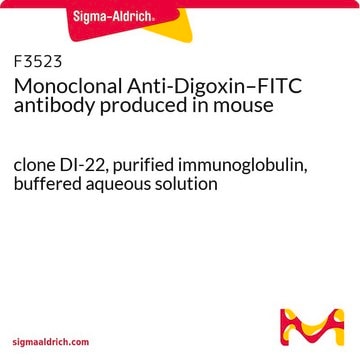11426320001
Roche
Anti-Fluorescein
from mouse IgG1 (clone B13-DE1)
Synonyme(s) :
antibody
Se connecterpour consulter vos tarifs contractuels et ceux de votre entreprise/organisme
About This Item
Code UNSPSC :
12352200
Produits recommandés
Source biologique
mouse
Conjugué
unconjugated
Forme d'anticorps
purified immunoglobulin
Type de produit anticorps
primary antibodies
Clone
B13-DE1, monoclonal
Forme
lyophilized
Conditionnement
pkg of 100 μg
Fabricant/nom de marque
Roche
Isotype
IgG1
Température de stockage
2-8°C
Description générale
Monoclonal antibody to fluorescein.
The detection of bound antibody can be carried out directly in one step using an anti-mouse Ig fluorochrome/enzyme conjugate, or in a two-step procedure with anti-mouse Ig fluorescein and, subsequently, anti-fluorescein enzyme conjugate.
The antibody does not contain any protein and can hence be used for coating and labeling.
Contents
Lyophilizate, stabilized
The detection of bound antibody can be carried out directly in one step using an anti-mouse Ig fluorochrome/enzyme conjugate, or in a two-step procedure with anti-mouse Ig fluorescein and, subsequently, anti-fluorescein enzyme conjugate.
The antibody does not contain any protein and can hence be used for coating and labeling.
Contents
Lyophilizate, stabilized
Spécificité
The monoclonal antibody reacts with free and bound fluorescein.
Application
Use Anti-Fluorescein for the detection of fluorescein-labeled compounds using:
- ELISA
- Immunohistocytochemistry
- In situ hybridization
- Western blot
Notes préparatoires
Working concentration: Working concentration of conjugate depends on application and substrate. The following concentrations should be taken as a guideline:
Working solution: Phosphate buffered saline, pH 7.4
Using water instead the antibody can precipitate.
- ELISA: 2 to 4 μg/ml
- Immunohistocytochemistry: 0.5 to 2 μg/ml
- In situ hybridization: 0.2 to 0.4 μg/ml
- Western blot: 0.5 to 2 μg/ml
Working solution: Phosphate buffered saline, pH 7.4
Using water instead the antibody can precipitate.
Reconstitution
Add 1 ml double-distilled water to a final concentration of 100 μg/ml.
Reconstitute for 15 minutes.
Reconstitute for 15 minutes.
Autres remarques
For life science research only. Not for use in diagnostic procedures.
Vous ne trouvez pas le bon produit ?
Essayez notre Outil de sélection de produits.
Mention d'avertissement
Warning
Mentions de danger
Conseils de prudence
Classification des risques
Aquatic Chronic 3 - Skin Sens. 1
Code de la classe de stockage
11 - Combustible Solids
Classe de danger pour l'eau (WGK)
WGK 2
Point d'éclair (°F)
does not flash
Point d'éclair (°C)
does not flash
Faites votre choix parmi les versions les plus récentes :
Déjà en possession de ce produit ?
Retrouvez la documentation relative aux produits que vous avez récemment achetés dans la Bibliothèque de documents.
Les clients ont également consulté
Ignacio E Schor et al.
Current biology : CB, 28(22), 3547-3561 (2018-11-06)
Long non-coding RNAs (lncRNAs) can often function in the regulation of gene expression during development; however, their generality as essential regulators in developmental processes and organismal phenotypes remains unclear. Here, we performed a tailored investigation of lncRNA expression and function
J Spielmann et al.
BMC obesity, 4, 24-24 (2017-07-12)
Obesity was identified as a major risk factor for malignant diseases, but underlying mechanisms remain unclear. Natural killer (NK) cells, a pivotal aspect of innate immunity, are capable of identifying and killing virally infected and tumor cells. Previous studies have
Comparing nucleic acid lateral flow and electrochemical genosensing for the simultaneous detection of foodborne pathogens.
Aissa A B, et al.
Biosensors And Bioelectronics, 88, 265-272 (2017)
Yufeng Liu et al.
Oncology reports, 44(2), 499-508 (2020-07-07)
Apurinic/apyrimidinic endonuclease 1 (APE1) is a primary nuclear‑localized multifunctional protein in osteosarcoma. However, the cytoplasmic localization of APE1 was found to be functional and to increase with cisplatin resistance, yet the molecular mechanism is unknown. In the present study, we explored
Gerard Terradas et al.
G3 (Bethesda, Md.), 12(1) (2021-11-19)
Gene drives are programmable genetic elements that can spread beneficial traits into wild populations to aid in vector-borne pathogen control. Two different drives have been developed for population modification of mosquito vectors. The Reckh drive (vasa-Cas9) in Anopheles stephensi displays
Notre équipe de scientifiques dispose d'une expérience dans tous les secteurs de la recherche, notamment en sciences de la vie, science des matériaux, synthèse chimique, chromatographie, analyse et dans de nombreux autres domaines..
Contacter notre Service technique










